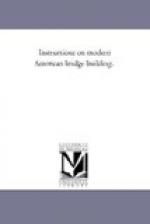=Bolsters.= Large timbers 12 x 12, or thereabouts, are laid on the bridge seats of the abutments to support the ends of the trusses, one of these should be directly under each of the extreme panel points. A panel point is the intersection of the centre line of a brace produced, with the centre line of a chord. The rise of a truss is the vertical distance between the centre lines of the upper and lower chords.
=Camber.= Were a bridge to be framed with its chords perfectly horizontal, it would be found to fall below the horizontal line on being placed in its proper position, owing to the closing up of the joints in the upper parts of the structure, and opening of joints in the lower parts, as well as to the compression of the parts. To obviate this defect, it is usual to curve the chords slightly in a vertical direction, by elongating the upper chord, so that the bays or panels are no longer rectangular but of a trapezoidal form—and, as a consequence, the inclined web members are slightly lengthened, and the verticals become radii of the curve. The amount of deviation from a horizontal line is called the Camber.
A table of Cambers for different spans will be found further on, as also a table of multipliers, by which to multiply the camber in order to find the elongation of the upper chord. Part of the Camber table is taken from Trautwine’s Engineer’s Pocket-Book, (which should be the inseparable companion of every engineer,) and part was calculated for this pamphlet, according to Trautwine’s rules. The table of multipliers is Trautwine’s.
=Diagonal Bracing.= In order to stiffen a bridge, it should have the two Trusses braced together at the Lower Chords always, at the Upper Chords when practicable—and in case of a deck bridge, where the roadway is supported on the upper chords, it is as well to have rods for vertical diagonal braces, their planes being perpendicular to the axis of the bridge. The more usual form is similar to the web members of the Howe Truss—the rods from 3/4” to 1” in diameter, and the braces of 6” x 7” scantling, footed on wooden blocks, usually. It is more usual to have the tie rods of the horizontal diagonal bracing, and the braces themselves, meet in a point about midway of a Truss panel on the centre line, nearly, of the chord. This will generally give a half panel of diagonal bracing near each end of the truss—and it is very usual to have the diagonals foot at their intersection there against a cross timber interposed between the trusses, while the tie rod prevents any spreading.
=Floor Timbers.= The general dimensions of the transverse floor beams, when about 3 feet apart, from centre te centre, are 8” x 14”, the largest dimension being the depth. The stringers should be notched to the floor beams about 1” or 2”, and should be about 10” or 12” x 14”. The cross ties should be 18” to 24” apart, from centre to centre, and be 3-1/2” x 6”.
Large, heavy bridges require no fastening to connect them with their seats, but light bridges should be fastened, as the spring on the sudden removal of a load, (as when the last car of a train has passed,) may move it from its proper position.




